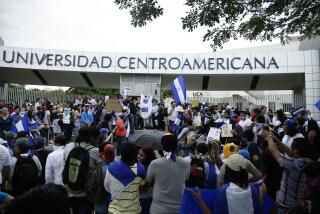‘Nicaraguan Obsession’
- Share via
An otherwise thoughtfully crafted editorial (Oct. 30), “Nicaraguan Obsession,” condemning the Reagan Administration’s mindless aggression against Nicaragua, was marred by the inclusion of terminology similar to that issued by the State Department.
The use of the term “cynical show trial” to describe the relatively calm, orderly process by which Eugene Hasenfus is being judged misleads the reader--it contradicts the newspaper and television coverage of this historic event.
This is the first time in the seven-year struggle that the Nicaraguan government has been able to set the agenda for worldwide discussion of the U.S. role in the contra war. The United States has been able to sweep side its defeat in the World Court and numerous attempts by the Nicaraguans to get attention.
Your editorial lamented this nation’s “isolated position” on Nicaragua, illustrated by its recent veto of a U.N. Security Council resolution urging compliance with the World Court decision that found the United States guilty of breaking international law in attacking Nicaragua. That veto got little attention in the news media.
Unfortunately, your cutting remark--”If the Sandinistas let down their guard and agree to stop threatening their neighbors . . . “--is straight out of the mouth of Ronald Reagan. That undercuts your entire argument, and in fact was part of the U.S. position rejected by the World Court! It’s also the line that confuses people about the necessity for contra aid.
Actually, the Reagan Administration long ago dropped its line that Nicaragua operates a supply line to guerrillas in El Salvador. U.S. officials have admitted there is no evidence. In fact, the military attache to the U.S. Embassy in Managua told me in July, 1985, that the Sandinistas hadn’t sent “more than a trickle” of small arms to El Salvador since 1981.
What the Hasenfus trial shows us is that it has been Salvadoran officials who have been plotting against Nicaragua, allowing contra aid to pass through their airport, and allowing these supplies of weapons to be guarded by some of the late dictator Anastasio Somoza’s former National Guardsmen. Perhaps the word “cynical” could be applied here because all of this was done with Washington’s knowledge.
As for other threatened neighbors, there is Costa Rica, which for years has allowed contra camps and secret airports--some of this revealed in a recent trial of mercenaries in San Jose. Costa Rican President Oscar Arias told me in July, 1986, that he does not believe Nicaragua poses any sort of a physical threat to his nation--the Sandinistas are a political and economic adversary and he opposes contra aid.
And finally, there is Honduras, a nation willing to turn over a large section of its territory to the contras and their U.S. advisers, and to thousands of U.S. National Guard troops, in return for hundreds of millions in U.S. aid dollars. Cynicism runs deep in Honduras.
It is time to end the “a pox on both houses” approach and more accurately describe the government distortions that have dominated U.S. thinking. This has been going on since the 1920s when the United States used planes to attack Nicaraguan villagers--in fact, Nicaraguan coverage of the Hasenfus trial included a 1927 photo of guerrillas led by Augusto Cesar Sandino standing near the wreckage of a U.S. plane that had been downed while making one of those attacks.
Eugene Hasenfus has been called a “hero” by U.S. officials. In 1927 President Calvin Coolidge praised the “heroic military action” of the U.S. pilots who used machine guns to kill Nicaraguans. And the editorial writers of those days probably called Sandino a “cynical” troublemaker who was a “threat” to democracy.
MICHAEL EMERY
Pacific Palisades
More to Read
Sign up for Essential California
The most important California stories and recommendations in your inbox every morning.
You may occasionally receive promotional content from the Los Angeles Times.









